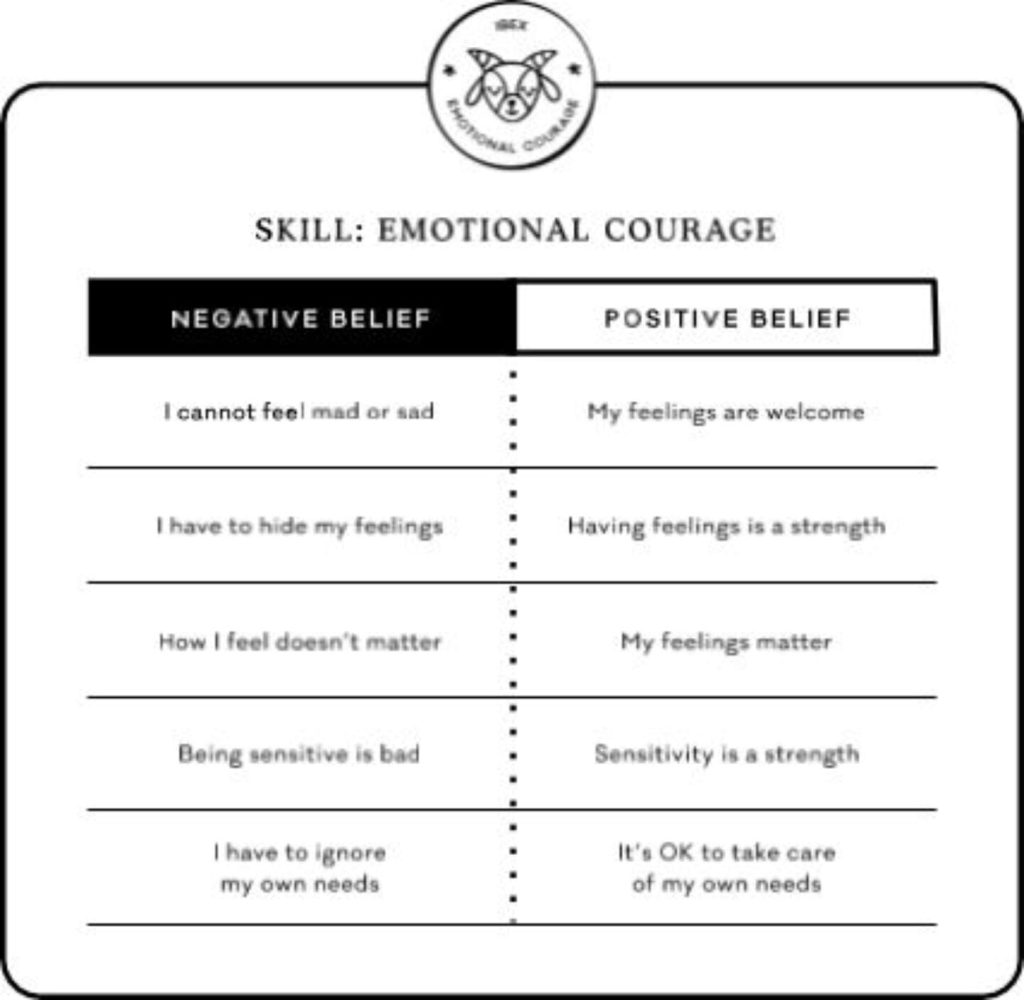Here’s how to help kids find their ’emotional courage’

Emotional courage refers to the capacity to embrace and express your emotions fully, even when it may be challenging or uncomfortable to do so. When you have emotional courage, you can acknowledge and value all feelings, regardless of whether they are perceived as positive or negative.
Emotional courage is rooted in the idea that all emotions are valid and integral to personal growth and understanding.
There are many benefits to embracing emotional courage, and we were inspired to highlight this skill as we (along with the rest of the world, seemingly) came to understand the importance of vulnerability. Brené Brown has been a champion at helping shift cultural awareness about the meaning of vulnerability when she defined it in her book, Braving the Wilderness, as:
The definition of vulnerability is uncertainty, risk, and emotional exposure. But vulnerability is not weakness; it’s our most accurate measure of courage. When the barrier is our belief about vulnerability, the question becomes: “Are we willing to show up and be seen when we can’t control the outcome?” When the barrier to vulnerability is about safety, the question becomes: “Are we willing to create courageous spaces so we can be fully seen?”
We want to help shift the narrative that being strong means being “controlling, hiding, or having no emotions.” We want kids to have a framework to learn about all of their emotions early on so the concept of emotional courage, feelings, and sensitivity will not point to weakness but rather to great strength, leadership skills, and courage.
We now know that old beliefs like the following have been working against us in our own systems:
- “Boys don’t cry.”
- “Put on a happy face.”
- “Grin and bear it.”
We want to help kids embrace all their emotions.
How to help kids welcome all feelings
When it comes to building emotional courage in our children, there are two concepts we want to teach our children:
- Being able to welcome emotions with curiosity
- Understanding that sensitivity (or feeling our feelings) is a strength
For emotional courage, the core belief that is being built is the concept of vulnerability and lovability.
Proactively building emotional courage
The kind of courage we want our future generation to embrace is not one of fake toughness, posturing, or making empty statements about greatness. It’s the kind of courage that is soft and strong at the same time. It’s the kind that opens our hearts instead of shutting them. Emotional courage is something we carry deep within us that helps us notice and embrace our tougher feelings. It’s about finding resilience through hard things and embracing tough conversations. It’s important for our children to know that we can be tough, open, and loving, all at the same time. For many of us, it’s a new type of courage to learn about. It is a courage that we grow from deep inside, one that we can practice and develop.
We believe that if children learn emotional courage from a young age, they will carry this learning into any role they take on as an adult. We all can benefit from exploring how to show up and do the right thing, even when it’s hard.
The ability to access emotional courage is such a supportive skill to offer a child for their life journey. When thinking about our own struggles that we have felt and seen, we believe emotional courage will empower children to handle a variety of difficult situations, many of which were not necessarily often outwardly discussed with us as children. Things like:
- Tolerating distressing and uncomfortable feelings (like sadness and guilt) without the need to avoid, numb feelings, or blame others
- Regulating emotions and learning from emotional states
- Asking for help when needed
- Feeling OK with not having all the answers
- Having conversations that may be uncomfortable but necessary
- Standing up for what you know is right
Modeling emotional courage
Emotional courage is not one of those things that we can just “tell” our children about; we have to show it. The way we relate to emotions, the things we value and don’t value, the things we respond to and don’t respond to are oftentimes unspoken “rules” in a family that everyone understands on some level, including children. This is why parents must be the ones to do the work first to make sure that children can learn from us as models of the behaviors and qualities we hope to grow in our children.
Here are some tips to help you get started if you are interested in building emotional courage in your family:
- Notice your feelings: If we can face our own feelings, even the really strong ones, then you can do anything!
- Accept all your feelings: We cannot move through a place of courage and bravery without acknowledging what is challenging us. Only once we accept what is can we move through it to a new place.
- Let go of perfection: We all have challenges, we all make mistakes, and we all have big feelings. When we let go of being “perfect,” it allows us to notice how things really are and shows us what we need to do from here.
- Listen to others: Sometimes we get caught in our own heads and our own feelings, but if we take a moment to peek out with curiosity, we can learn from others and access information that can be really helpful to us.
Building emotional courage means coming back to core beliefs about being able to handle and hold all emotions by understanding that our emotions are messengers for our deeper needs. Emotional courage is not a destination; it’s a journey. It’s a constant process we can engage in to listen deeply to ourselves and others, and it’s a conscious choice to value empathy and love over toughness and power.
All Feelings Welcome: Parenting Practices for Raising Caring, Confident, and Resilient Kids, published by Wiley and co-authored by Kelly Oriard and Callie Christensen is available for purchase on Amazon, Bookshop, and wherever books are sold. Excerpt reprinted with permission from publisher.






